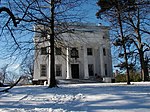Stapleton Heights, Staten Island

Stapleton Heights (or Stapleton Hill) is a neighborhood in northeastern Staten Island, New York City. It stands on the second of a series of hills that form a "backbone" running diagonally across the island from northeast to southwest, between Ward Hill (the first of the hills as they rise from Tompkinsville) and Grymes Hill; to the east is Stapleton, which is along the waterfront. It is an upper-middle-class enclave noted for its large older one-family homes, and for its view of Upper New York Bay and the Verrazano Narrows Bridge. Many of the grander homes of the neighborhood were constructed in the late 19th century by the families who controlled the industries along the waterfront, including the breweries that operated there until the last one closed in 1963. One such home, on Louis Street, is allegedly "haunted," according to local residents. Stapleton Heights is served by the S52 and S78 local buses.
Excerpt from the Wikipedia article Stapleton Heights, Staten Island (License: CC BY-SA 3.0, Authors, Images).Stapleton Heights, Staten Island
Occident Avenue, New York Staten Island
Geographical coordinates (GPS) Address Nearby Places Show on map
Geographical coordinates (GPS)
| Latitude | Longitude |
|---|---|
| N 40.630138888889 ° | E -74.084444444444 ° |
Address
Occident Avenue 17
10304 New York, Staten Island
New York, United States
Open on Google Maps





